
American photographer and environmentalist Ansel Adams said, “Photography, as a powerful medium of expression and communications, offers an infinite variety of perception, interpretation, and execution.” Adams’ words aptly describe the distinctive yet disparate photographic directions taken by IIT Institute of Design alumni Barbara Crane (M.S. PHOT ’66) and Robert E. David (M.S. DSGN ’73). While Crane, a groundbreaking artistic photographer, and David, official photographer for the Golden Gate Bridge Highway and Transportation District, have never met, they share several things in common besides their alma mater: a level of mastery in their chosen genres, a friend and colleague in Adams, and a love of the cities they each call home.
Visit magazine.iit.edu/category/online-exclusives to read expanded profiles on both Crane and David. Crane’s work can be seen in the exhibit Barbara Crane, Then/Now: The Eternal Thread of the ID Aesthetic, in the Kemper Room Art Gallery at IIT’s Paul V. Galvin Library through February 1. An exhibit of David’s photographs of the Golden Gate Bridge and the surrounding San Francisco Bay Area will be on display in IIT’s Hermann Hall Gallery Lounge, beginning with a reception on January 26. The exhibit will run through March 15.
For more information, visit www.iit.edu/art.
BARBARA CRANE
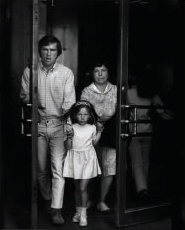
“I began to think specifically about the unique diversity of people in Chicago and chose the Museum of Science and Industry as the stage from which to view the massive cross-section of humanity that moves through its doors,” says Crane. “The museum’s visitors served as a microcosm of the city’s race, class, age, and nationality, and as a way to look at the commonalities they all share.”

“The crush of people moving toward Union Station at the end of the day is fragmented by shapes created by light and shadow streaming down the canyons between buildings in the city,” says Crane, who is part of the photograph as the shadow figure with the large bag over her arm. The quality of light, notes Crane, is essential to all of her imagery.
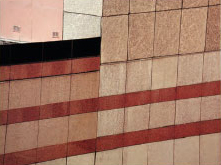
Crane shot Urban Anomalies from Chicago’s “El” platforms, which allowed her to obtain unique views and look down onto rooftops of various neighborhoods. “The series explores the abstraction that occurs when a photographic frame is imposed on the architecture of the city,” Crane says.
American photographer and environmentalist Ansel Adams said, “Photography, as a powerful medium of expression and communications, offers an infinite variety of perception, interpretation, and execution.” Adams’ words aptly describe the distinctive yet disparate photographic directions taken by IIT Institute of Design alumni Barbara Crane (M.S. PHOT ’66) and Robert E. David (M.S. DSGN ’73). While Crane, a groundbreaking artistic photographer, and David, official photographer for the Golden Gate Bridge Highway and Transportation District, have never met, they share several things in common besides their alma mater: a level of mastery in their chosen genres, a friend and colleague in Adams, and a love of the cities they each call home.
Visit magazine.iit.edu/category/online-exclusives to read expanded profiles on both Crane and David. Crane’s work can be seen in the exhibit Barbara Crane, Then/Now: The Eternal Thread of the ID Aesthetic, in the Kemper Room Art Gallery at IIT’s Paul V. Galvin Library through February 1. An exhibit of David’s photographs of the Golden Gate Bridge and the surrounding San Francisco Bay Area will be on display in IIT’s Hermann Hall Gallery Lounge, beginning with a reception on January 26. The exhibit will run through March 15.
For more information, visit www.iit.edu/art.
ROBERT E. DAVID
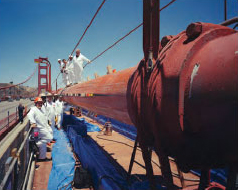
“Every 10 years the main cable of the bridge is thoroughly inspected,” says David. “This photo shows where a 50-foot section of the main cable has been unwrapped and wedges have been driven into the wire strands to separate them to permit visual inspection of the interior strands.” The bridge’s main cable consists of 27,572 strands of 0.196-inch thick galvanized-steel wire arrayed into a 36-inch diameter circle.
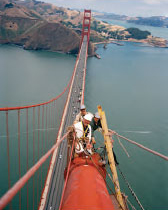
“As part of the once-per-decade main cable inspection, cable bands and their associated bolts are scrutinized for structural integrity and appropriate tension,” says David. “Cable bands hold vertical suspender ropes in position every 50 feet along the main cable.” This photo, which shows the cable band nearest the top of the south tower, demonstrates the process of measuring the tension in one of the bolts.
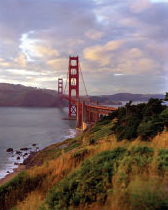
“As I frequently do, I was on the lookout for colorful sunset conditions and was able to get to this location and set up my 8” x 10” camera in time to capture the moment at 8:15,” says David. “The ¼-second exposure accounts for the blurs in the windswept foreground grass and the automobile traffic on the bridge. People frequently say that this photograph has a ‘painterly’ quality. In light of its apparent popularity, I published it as a poster.”
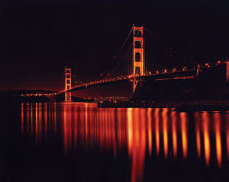
This night photograph taken from the United States Coast Guard station at the north end of the bridge was David’s first for the new millennium. “The very clear and calm evening provided exceptional and peaceful conditions, allowing for the deep reflections of the bridge’s illumination in the waters of San Francisco Bay,” David explains. “A four-minute time exposure, including reciprocity allowance, enhanced this effect.”